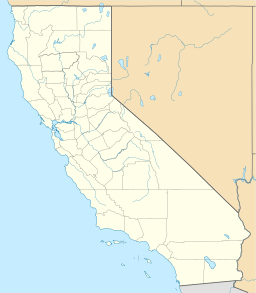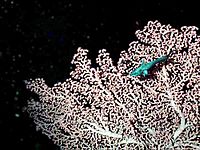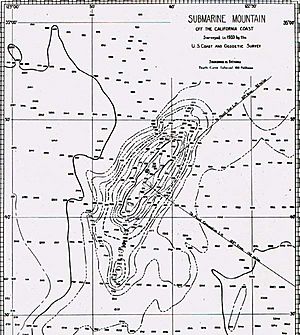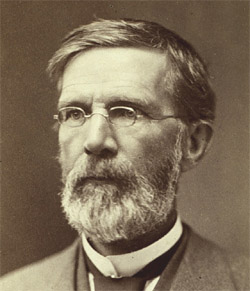Davidson Seamount facts for kids
Quick facts for kids Davidson Seamount |
|
|---|---|
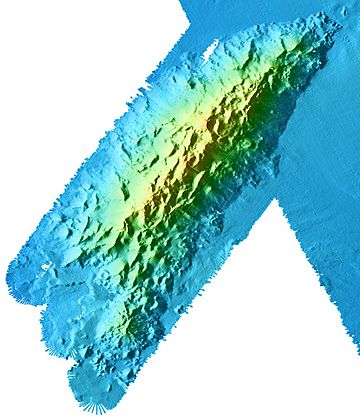
Bathymetric map of Davidson Seamount.
|
|
| Summit depth | 4,101 ft (1,250 m) |
| Height | 7,480 ft (2,280 m) |
| Location | |
| Coordinates | 35°43′N 122°43′W / 35.717°N 122.717°W |
| Country | California, United States |
| Geology | |
| Type | Seamount (underwater volcano) |
| Age of rock | 9–15 million years |
| Last eruption | ~9.8 million years ago |
| History | |
| Discovery date | 1933 |
Davidson Seamount is a huge seamount, which is an underwater volcano. It is found off the coast of Central California. This amazing place is about 80 mi (129 km) southwest of Monterey. It is also about 75 mi (121 km) west of San Simeon.
Davidson Seamount is one of the biggest seamounts known in the world. It is 26 mi (42 km) long and 8 mi (13 km) wide. From its base to its top, it stands 7,480 ft (2,280 m) tall. But its peak is still 4,101 ft (1,250 m) below the ocean's surface. This seamount is full of life. Scientists have found 237 different species there. They have also identified 27 types of deep-sea coral.
Davidson Seamount was first found in 1933. This happened when people were mapping California's coast. It was named after George Davidson. He was a geographer from the U.S. National Geodetic Survey. For many years, it was not studied much. But in 2002 and 2006, NOAA teams explored it. They learned a lot about its special deep-sea coral world.
The seamount has many old, large corals. Some of these corals are over 100 years old. The information from these studies helped make Davidson Seamount a part of the Monterey Bay National Marine Sanctuary in 2009. This protects the area.
Contents
What is Davidson Seamount?
A seamount like Davidson is an underwater volcano. This one rises 7,480 ft (2,280 m) above the ocean floor around it. There are over 30,000 seamounts just in the Pacific Ocean. But only about 0.1% of them have been explored. Because it is underwater, it acts differently from volcanoes on land.
Its surface is mostly made of blocky lava flows. Some pillow lava is also found deeper down. Pillow lava is common for seamounts. The top of the seamount has layers of volcanic ash and pyroclastic material. These rocks show that the volcano had mild, explosive eruptions. These eruptions happened near the top with gas-rich lava. The bottom of Davidson is likely covered in thick mud.
How Big is Davidson Seamount?
Davidson Seamount is very large. It is 26 mi (42 km) long and 8 mi (13 km) wide. If it were on land, it would look as big as Mount Shasta. Mount Shasta stands out in northern California. To give you an idea, Davidson Seamount is big enough to fill Monterey Bay. It would stretch from the Santa Cruz boardwalk to Monterey's Fishermen's Wharf.
How Did Davidson Seamount Form?
Davidson Seamount is part of a group of seamounts. These include Guide, Pioneer, Gumdrop, and Rodriguez. They are all found off the coast. This group of seamounts looks very similar to each other. They are complex structures that run northeast-southwest. They have parallel ridges with mud-filled valleys between them.
These ridges formed along an old spreading center. This was a place where the Earth's plates moved apart. Now, the San Andreas Fault system does this job. These seamounts are special because they formed from an old ocean-ridge spreading center. They have a series of "knobs" lined up with the ridges. But they do not have a clear crater at the top. Most ocean volcanoes have one. This means magma was probably not stored inside Davidson Seamount like in other volcanoes.
Studies show that Davidson Seamount formed between 9 and 15 million years ago. This was 5 to 12 million years after the ocean floor above it formed.
Life at Davidson Seamount
Scientists say that a seamount is like an "oasis of life." It has more species and biodiversity than the ocean floor around it. Seamounts are important for life for several reasons. They rise high in the water, which creates special currents. These currents bring food and support life on, around, and above the seamount. The seamount's surface also gives organisms a place to attach and grow. This helps the animals that feed on them, supporting the whole food web.
Scientists have found that seamounts often provide a home for endemic species. These are species found nowhere else. Davidson Seamount is one of the most studied seamounts for its biology. Six big trips to the volcano have led to over 60,000 observations of species.
As of 2009, scientists have seen and recorded 168 types of large animals (called megafauna) on the seamount. About 7% of these species live only at Davidson. Most species (71%) are found in many places around the world. For 22% of species, there is enough data to show they are not only found on seamounts. The last 7% have only been seen in videos. Thirteen species have been found in other areas, but never on other seamounts.
The seamount is home to many deep-sea corals. Most of these corals provide homes for other species. It has been called "An Oasis in the Deep." It has a huge coral forest, large sponge fields, crabs, deep-sea fish, basket stars, and rare benthic species. Some of these species have not even been named yet. These are all cold-water species. The water temperature at the top of the seamount is just above freezing, about 2 °C (36 °F). The ocean surface is much warmer, around 14 °C (57 °F).
Even though it is huge, the top of Davidson Seamount is still over 4,500 ft (1,372 m) below the ocean's surface. This great depth means that human activities have not disturbed the habitats much. Things like anchoring and trawling usually do not happen below 1,500 ft (457 m). Also, waste is usually dumped much closer to shore.
When compared to the nearby Monterey Bay National Marine Sanctuary, Davidson Seamount is very different. Species that are rare in Monterey Bay are common on Davidson, and vice versa.
Deep-Sea Corals and Sponges
The life on Davidson Seamount is mostly made up of a large "forest" of old deep-sea corals and sponges. Some of these are over 100 years old. While these species grow elsewhere, they are usually spread out and much smaller and younger than the corals on Davidson. On the other hand, sea cucumbers are very common in Monterey Canyon. But they are almost completely missing from Davidson. This shows how different the two areas are.
Scientists think Davidson Seamount is a perfect home for deep-sea corals and sponges. It has good rocky surfaces (bare lava rock) that do not collect much mud. It also has a steady food supply from ocean currents. And it has not been disturbed by strong bottom currents that affect other seafloor areas.
Craig McClain, a scientist studying the seamount, explained:
"The large groves of corals and sponges are unique to seamounts. The crests of seamounts are particularly good because they provide flat rocky surfaces that don't accumulate much sediment. This is partly due to the fact that seamounts are so far offshore. In contrast when you look at the seafloor in Monterey Canyon, it's mucky. That makes it tough for filter feeders, especially sponges. Any flat surface in the canyon collects mud. This makes it tough for corals to settle anywhere except on near-vertical surfaces. Just staying attached to these surfaces can be a challenge in itself."
Research also suggests that seamounts like Davidson Seamount may be important for rare species. They might use them as breeding grounds. Seamounts are likely a source of larvae that help keep populations of species alive in nearby areas. These nearby areas might not be as good for living. Future DNA studies might help scientists prove that seamounts are indeed sources of larvae for the surrounding seafloor.
History of Discovery and Exploration
Davidson Seamount was first found and mapped in 1933. In 1938, the United States Board on Geographic Names officially called it a "seamount." It was the first underwater volcano to get this name. It was named after George Davidson. He was a scientist who helped map America's west coast for the U.S. National Geodetic Survey.
Because it is so deep, Davidson Seamount was not studied much for a long time. Scientists who study volcanoes (called volcanologists) are interested in its unique geology. Biologists are interested in its special ecology. In 2002, the NOAA supported the first modern, in-depth study of the seamount. The team included scientists, teachers, and resource managers. Their goal was to record species, collect rock samples, and describe the ocean environment. They found many rare and new species that live nowhere else. This included ancient coral gardens that are easily harmed by human activity.
More recent trips to Davidson have focused on its ecology. They especially looked at the many deep-sea corals, some over 100 years old, that live there. These large coral groups are very fragile. Davidson is close to scientific research centers. This has helped its exploration. Many dives, mappings, and studies have made it one of the best-studied seamounts in the world.
In 2006, another exploration happened. It was a team effort by the Monterey Bay National Marine Sanctuary, the Monterey Bay Aquarium Research Institute (MBARI), and Moss Landing Marine Laboratories. This trip mainly tested a model to predict where corals would be found. It also helped scientists understand the seamount's deep-sea coral better. The NOAA set four goals for this trip:
- Understand why deep-sea corals live where they do on the seamount.
- Find out the age and how bamboo corals grow.
- Make the list of coral species from the seamount better.
- Share the exciting experience with the public through TV and the Internet.
Scientists collected information on water currents and food availability. They also gathered data on the age and growth patterns of the corals. The British Broadcasting Corporation filmed the trip for their show, Planet Earth. During the trip, 70 hours of observations were made. Also, 102 deep-sea animal and rock samples were collected. The expedition lasted from January 26 to February 4. It used the MBARI's research vessel Western Flyer and the ROV Tiburon.
Becoming a Marine Sanctuary
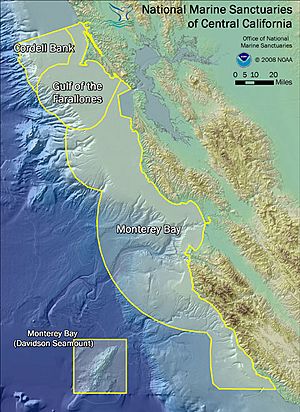
After the 2002 and 2006 trips, many people wanted Davidson Seamount to become a marine sanctuary. In 2006, a group of scientists, fishermen, officials, and teachers was formed. They discussed whether to make Davidson Seamount a United States National Marine Sanctuary. They also talked about whether it should be its own sanctuary or part of the nearby Monterey Bay National Marine Sanctuary. The group decided the seamount should be a sanctuary. Most of them suggested adding it to the Monterey Bay sanctuary.
The Monterey Bay advisory group agreed with these findings. They sent their approval to the NOAA. The NOAA had the final say. On November 20, 2008, the NOAA approved the plans. They expanded the Monterey Bay Sanctuary by 775 sq mi (2,007 km2) to include Davidson Seamount. After a plan was made, Davidson Seamount became part of Monterey Bay in 2009. This was 7 years after it was first suggested.
Protecting Davidson Seamount
In July 2017, the U.S. Department of Commerce began looking again at the protection status of the Monterey Bay National Marine Sanctuary. This sanctuary includes the Davidson Seamount. Many environmental groups and local people did not agree with this review.


